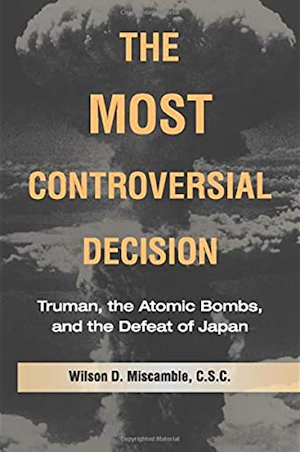By Jay M. Pasachoff
Notre Dame professor Wilson Miscamble has previously written about the blindly unforeseen handoff of the American government from Roosevelt to Truman on April 12, 1945, during the endgame of World War II. He now brings his wise and wide-ranging knowledge of the complicated decisions left for the American president at that time to one specific major decision: whether to drop the atomic bomb on Japan.
Miscamble is well aware of the flap at the Smithsonian Institution a few years ago about its prospective exhibition on the Enola Gay, the plane that dropped the “Little Boy” uranium-235 atomic bomb on Hiroshima, and of the “revisionist” points of view that there were alternatives to dropping the bomb on first one and then another populated Japanese city. Only with the historical background that is lacking for most of us can we come to understand the circumstances and whatever alternatives there might realistically have been.
He starts his discussion by providing us with the history of the atomic-bomb project, from Einstein’s (prompted by Leo Szilard) unappreciated letter to FDR describing the possibility of a superbomb, and the appointment of General Groves and J. Robert Oppenheimer to head the Manhattan Project with its major bomb-inventing site at Los Alamos. (See the review by Naomi Pasachoff and me of John Adams’s and Peter Sellars’s opera Dr. Atomic in Nature Physics, 1 November 2005.)
He continues with the background of Harry Truman, who became a U.S. Senator out of Kansas City’s Prendergast machine politics, and who was therefore scorned by Yale Skull-and-Bones alumnus Henry Stimson, the Secretary of War. When Truman, in charge of a Senate committee to root out waste in defense work, tried to find out why the government had bought 200,000 of farmland in the Hanford-Pasco—White Bluffs region of Washington State, Stimson told Truman that it “was part of a very important secret development” and that he shouldn’t ask further. Stimson was later again annoyed when Truman tried to ask about waste in the “Pasco Project,” knowing only that there would be “a plant to make a terrific explosion for a secret weapon that would be a wonder.” (Near Hanford and Pasco, we now find a site of the Laser Interferometer Gravitational Wave Detector, LIGO, a major National Science Foundation project to open astronomical observation of space to an entirely new method.)
As is widely known, FDR’s health was precarious as he bargained with Churchill and Stalin at Yalta (do I need to follow my normal rule of explaining what initials stand for?; after all, I discovered that most college students haven’t heard of Oppenheimer), but it was still a shock when Truman was called to the White House, expecting to see the president, but was told by Eleanor Roosevelt, “Harry, the President is dead.” Miscamble quotes the famous interchange when Truman asked “Is there anything I can do for you?” and Mrs. Roosevelt’s responded “Is there anything we can do for you for you are the one in trouble now?” In these 2011 days of the Arab Spring, it is rewarding to read about the smooth, unquestioned transfer of American power under the fierce, wartime circumstances of 1945.
Miscamble makes clear the background of why Truman had been left out of any conceivable loop of briefing about international affairs, and that such a decision as to whether a new type of bomb should be dropped was not only not conceivable at the time but also far from the most urgent decision the new president would have to make.
The key idea, as expressed by “Jimmy” Byrnes, whom Truman brought in as Secretary of State (replacing Edward Stettinius) and key political advisor, was that “both the public and their representatives would be outraged if the Truman administration were later shown to have displayed any reluctance to win the war with Japan as quickly as possible by forgoing the use of this weapon.” All other considerations, including those now cited by revisionists, were less important than domestic politics at the time. As Miscamble describes, “Whatever the subsequent controversy, Truman had to make no profound and wrenching decision to use the atomic weapon.” That question never came up as such. “Yet, one must acknowledge that Truman possessed neither the capacity nor the desire to question the logic of the bomb’s use.” Miscamble concludes, “The time has come at long last to explode permanently the myth of a Japan ready to surrender.”
I am someone whose father (who had landed at Normandy in the U.S. Army’s medical corps) had, at Germany’s defeat, orders in his pocket to redeploy to Japan. So it was not hard for Miscamble to convince me of his conclusion that Truman really had no choice: he had to try to save the lives of hundreds of thousands of Americans by dropping the atomic bombs on Hiroshima and Nagasaki. Still, for all Americans and for the world at large, it is useful and important to see the history of the political and military situations laid out so clearly.
With so many young people born having no memory of World War II or even of its veterans, Miscamble’s short and clear book (with unobtrusive and skippable but academically reassuring footnotes), which includes 16 very well-chosen photographs, provides an important background that we should all share.
Astronomer and author Jay M. Pasachoff (ΦBK, Williams College) is the director of the Hopkins Observatory and Field Memorial Professor of Astronomy at Williams College. He is a visitor in the Carnegie Observatories. Williams College is home to the Gamma of Massachusetts chapter of Phi Beta Kappa.




